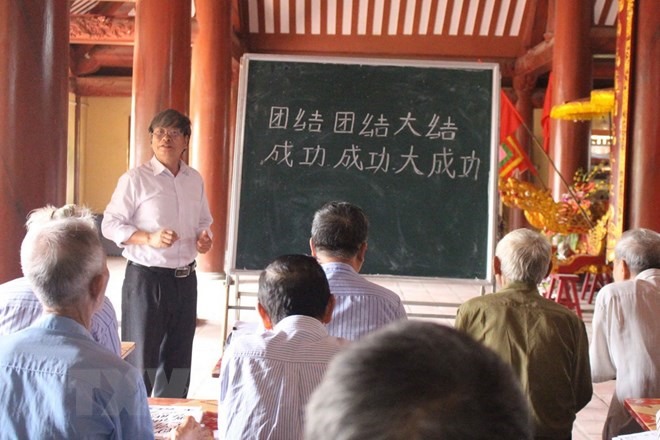

Elderly people are learning a very old way of writing. It comes from the Hán Nôm culture. There are a lot of historic and interesting Hán Nôm documents in the northern province of Vĩnh Phúc. However, few have been able to read them.
 |
| New tricks: Elderly people are studying at the Hán Nôm class in Vĩnh Tường District, Vĩnh Phúc Province. |
Elderly people are learning a very old way of writing.
It comes from the Hán Nôm culture.
There are a lot of historic and interesting Hán Nôm documents in the northern province of Vĩnh Phúc.
However, few have been able to read them.
by Nguyễn Thị Thảo
Every Friday morning, about 20 elderly people in the northern province of Vĩnh Phúc gather at the communal house in Thượng Trưng Commune, Vĩnh Tường District for a class in ancient scripts, widely used in Việt Nam until the 19th century—and still the scripts in which millennia of Vietnamese history and literature is recorded.
Many students in the special class are over age 60. The class has run since mid-2016 with the aim of helping local people enrich their knowledge of the Hán-Nôm (Chinese Han and Vietnamese Nôm ideographic) scripts and improve their skills of reading and writing in the characters. It also aims to promote people’s awareness about the preservation of the Hán-Nôm culture.
Phạm Văn Thúc, 78, the teacher and founder of the class, said he got the idea of teaching Hán-Nôm scripts to lcal elderly people when he learned that his homeland in Thượng Trưng Commune was rich in traditional culture, including various ancient horizontal lacquered boards and woodblocks engraved with Hán-Nôm characters.
“Such precious heritage, particularly those items relating to Hán-Nôm scripts, is proof that Thượng Trưng Commune is a region with a tradition of studiousness,” said Thúc.
The teacher revealed that the commune had an abundance of ancient documents and evidence of achievement in education including writings and books about Hán-Nôm, though few local people could read them because they did not know the ideographic characters.
“The initiative to open such a class is first aimed to help people understand more about their ancestors’ education and study traditions, and then they can teach younger generations how to follow the traditions,” said the teacher.
Thúc said the class had been opened for two years with about 20 students regularly attending lessons.
He also invited other Hán-Nôm teachers from across the province to help the class work through the difficult aspects of the lessons.
Lê Xuân Khoan, the oldest student at age 85, said he rode a bicycle more than 10km to reach the class.
“I learn Hán-Nôm as a way to enrich my knowledge about the ancient Vietnamese language, show my children that study is never too late for anybody and prove that Hán-Nôm is always an important part of our life,” said Khoan.
Khoan, who is living in neighbouring Tuân Chính Commune, said his father who used to be a scholar teaching Chinese Han script taught him some words but he could not remember them when he grew up.
“Now, I study first then I will teach my children as a way to make them understand more about our ancestors as well as to preserve our tradition,” said Khoan.
“Studying Hán-Nôm is extremely hard for all people, especially the elderly due to our health conditions and limited memory but we will try our best,” said student Bùi Văn Thọ, 75.
Thọ said the teachers had collected many documents for students to read and practise spelling including those written by Nguyễn Du, the well-known writer of Truyện Kiều (Kiều’s Tale), and by President Hồ Chí Minh, who was an expert at the Hán-Nôm language.
Thúc said that to make students more interested in the lessons, the class held many field trips to historical relics across the country where the Hán-Nôm literature was preserved.
At present, Thúc said he and some other teachers were also running another class for young students in Vĩnh Sơn Commune also in Vĩnh Tường District.
The class has not only become a good socio-cultural activity but also helped promote youth awareness on the preservation of local ancient traditions, said Thúc.
For thousands of years, Hán-Nôm characters were used to record Việt Nam’s culture and history, yet fewer and fewer young people know how to read and write the scripts.
Associate professor Dr Trịnh Khắc Mạnh, former director of the Hán-Nôm Institute, said Việt Nam had invaluable literary works written in the old logograms on historical and medicinal topics that had saved lives in the past.
"These collections were left to us by our ancestors," said the expert.
"Despite its importance to Vietnamese people, it has not been given proper attention by cultural authorities," Mạnh said.
"Fewer and fewer young people know how to write a traditional document in Han Chinese. This has caused a widening cultural gap between generations," said the expert.
"We should educate Vietnamese young people in the heritage of Hán-Nôm by teaching the scripts in schools," said Mạnh, adding that the process would be difficult because Hán-Nôm lecturers are very rare now. VNS
GLOSSARY
Every Friday morning, about 20 elderly people in the northern province of Vĩnh Phúc gather at the communal house in Thượng Trưng Commune, Vĩnh Tường District for a class in ancient scripts, widely used in Việt Nam until the 19th century—and still the scripts in which millennia of Vietnamese history and literature is recorded.
A communal house is one shared by a number of people.
Ancient scripts are very old pieces of writing.
Millennia means “thousands of years”.
Literature is what is written in books.
If something is recorded, it is written down and kept somewhere in case it is needed again in the future.
It also aims to promote people’s awareness about the preservation of the Hán-Nôm culture.
To promote, in this case, means to improve.
Preservation means the keeping of something that is old, fresh.
Phạm Văn Thúc, 78, the teacher and founder of the class, said he got the idea of teaching Hán-Nôm scripts to local elderly people when he learned that his homeland in Thượng Trưng Commune was rich in traditional culture, including various ancient horizontal lacquered boards and woodblocks engraved with Hán-Nôm characters.
The founder of the class is the person who began it.
If something is horizontal, it lies in a flat position with one narrow side facing left and the other narrow side facing right and the longer sides facing up and down.
Lacquered means coated in a substance that is like varnish.
“Such precious heritage, particularly those items relating to Hán-Nôm scripts, is proof that Thượng Trưng Commune is a region with a tradition of studiousness,” said Thúc.
Studiousness means studying a lot.
The teacher revealed that the commune had an abundance of ancient documents and evidence of achievement in education including writings and books about Hán-Nôm, though few local people could read them because they did not know the ideographic characters.
To reveal something means to tell people about something not many people may have known about.
If there is an abundance of ancient documents, there are many of them.
Evidence means proof.
Ideographic characters are displayed as symbols, or figures, rather than in words.
“The initiative to open such a class is first aimed to help people understand more about their ancestors’ education and study traditions, and then they can teach younger generations how to follow the traditions,” said the teacher.
An initiative is an idea.
Khoan, who is living in neighbouring Tuân Chính Commune, said his father who used to be a scholar teaching Chinese Han script taught him some words but he could not remember them when he grew up.
A scholar is someone who is well educated in a certain field.
“Studying Hán-Nôm is extremely hard for all people, especially the elderly due to our health conditions and limited memory but we will try our best,” said student Bùi Văn Thọ, 75.
If you have limited memory you are not able to remember much.
Associate professor Dr Trịnh Khắc Mạnh, former director of the Hán-Nôm Institute, said Việt Nam had invaluable literary works written in the old logograms on historical and medicinal topics that had saved lives in the past.
A logogram is a sign or a character that represents a word or a phrase.
"We should educate Vietnamese young people in the heritage of Hán-Nôm by teaching the scripts in schools," said Mạnh, adding that the process would be difficult because Hán-Nôm lecturers are very rare now.
Rare means not common.
WORKSHEET
Find words that mean the following in the Word Search:
c | f | m | o | y | t | u | j | s | g | u | d |
h | r | b | s | b | l | b | d | n | f | e | r |
f | u | i | i | p | p | y | a | j | o | ễ | b |
r | i | t | e | a | c | h | e | r | k | e | i |
e | t | u | w | i | a | y | s | u | r | l | c |
n | e | h | h | o | n | b | g | h | c | e | y |
c | s | a | g | b | r | a | d | g | e | b | c |
h | f | u | c | e | b | o | l | k | a | c | l |
b | r | q | v | h | f | r | i | d | a | y | e |
h | o | t | e | n | t | a | l | n | a | n | r |
© Duncan Guy/Learn the News/ Viet Nam News 2018
1. Friday; 2. Two; 3. Bicycle; 4. Ten; 5. Teacher.




